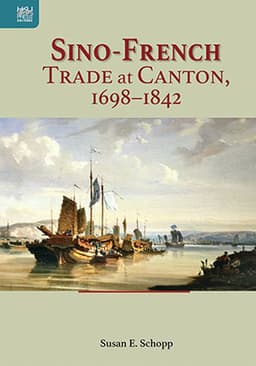
Book Review
Sino-French Trade at Canton, 1698-1842, 2020
By Susan E. Schoop
Buy the book: https://hkupress.hku.hk/index.php?route=product/product&product_id=1174&search=schopp
Since the publication of The Canton Trade: Life and Enterprise on the China Coast, 1700-1845 by Paul Van Dyke in 2005, Canton trade history has experienced a renaissance. Gone are the days when historians considered Qing China backward and archaic. They portrayed the Chinese ‘Hong’ tea merchants as inept and greedy while relying almost solely on the records of the British East India Company. Armed with impressive language and research skills, Van Dyke and his students are now opening our eyes to a much wider range of sources, perspectives, and agents in the history of international commerce in Canton. This, in turn, allows us to tell new narratives about Sino-European trade and relations. Susan Schopp’s book, Sino-French Trade at Canton, 1698-1842, told from the perspective of a vast array of French archival sources, is a recent and valuable addition to this burgeoning field of global business history connecting Europe and China.
Schopp’s meticulously researched monograph, in fact, offers us the first book-length study dedicated solely to the French in Canton. A combination of factors including a lack of interest in French imperial history, difficulties accessing archives (including the loss of the records of the First and Second French Compagnies), as well as an impression that the French footprint on the Canton trade was lighter than that of the British and Dutch, have all contributed to a long silence around Sino-French trade during the Canton era. In order to show “that the French did indeed constitute a separate model, quite distinct from those of the other two major companies” worthy of our attention, Schopp draws upon a wide range of primary sources (2). These include the archives of several European East India Companies, the archives of the third French Compagnie, a collection of correspondence received by the Secretary of State of the Navy from the East and South East Asia on French trade in the Archives Nationale D’outre-Mer in Aix-en-Provence, records of the Service Historique de la Defense, logbooks of the Compagnie’s China voyages in the French National Archives, collections in departmental and municipal archives (particularly Brittany) as well as in private collections, in addition to the papers of private traders held in the diplomatic archives at La Courneuve, which with few exceptions have been ignored
This painstaking archival research allows the author to make a number of important arguments and contributions to the field of business history in the global port city of Canton. First, Schopp presents major aspects of the French experience, explains how that experience evolved over time, and does so with an uncanny ability to combine forensic precision with succinctness. Secondly, she demonstrates the importance of a multi-national approach to the history of the Canton trade where the ‘tyranny’ of British East India Company sources has limited and, at times, skewed our historical perspective. Thirdly, the author sheds light on the contours and structures of France’s distinctive model of Sino-European trade; and finally, Schopp supports the contention, first articulated by Van Dyke, that the Canton system created an extremely productive and well-administered global port city.
In addition to these valuable methodological and historiographical contributions, this book also holds a great deal of precious information for those interested in business history and the China trade. The book’s chapters survey various aspects of French involvement in Canton including the way the Compagnies were structured and trade was conducted as well as information about the ships and vessels used in the trade, patterns in the various voyages and sea routes taken including ports of call, the importance and evolution of the French Hong in Canton, the everyday work and social life of the Compagnie’s merchants, and brief biographical sketches of over thirty notable French traders, consular staff, hydrographers, naturalists, and others. This great variety of fine- grained archival research will undoubtedly offer much to different historians, researchers, and lay readers depending on their specific interests and scholarly agendas.
In the view of this reader, (who happens to be a historian of the British East India Company), some of Schopp’s most interesting and insightful discussions center on the unique business structure of the French Compagnies in comparison with the other EIC’s as well as the unusually important role played by French private traders. Unlike the British and Dutch East India Companies, the French Compagnies were created by the state itself, with the Crown assuming a dominate role in their administration and organization. And yet, seemingly paradoxically, France opened its East India and China trade to the private sector and “put a definitive end to the company model” before the British and Dutch did (133). It was private traders, not Compagnie ships, that kicked off France’s maritime trade with China in the seventeenth century. And during the period of France’s participation in the Canton trade between 1698 and 1842, commerce was legally open to private merchants nearly half of that time. For these reasons Schopp provocatively suggests that the French experience should lead us to reconsider the distinction historians usually make between ‘private’ and ‘company’ because “the distinction is far more nuanced, requiring a redefinition not only of ‘private’ and ‘company,’ but also of the terms ‘Europe’ and ‘intra-Asian’ (‘country’)” (134).
Jessica Hanser
University of British Columbia